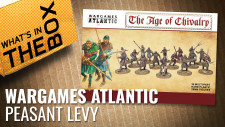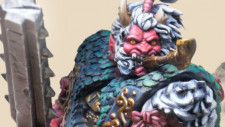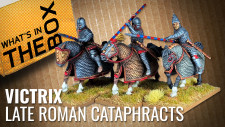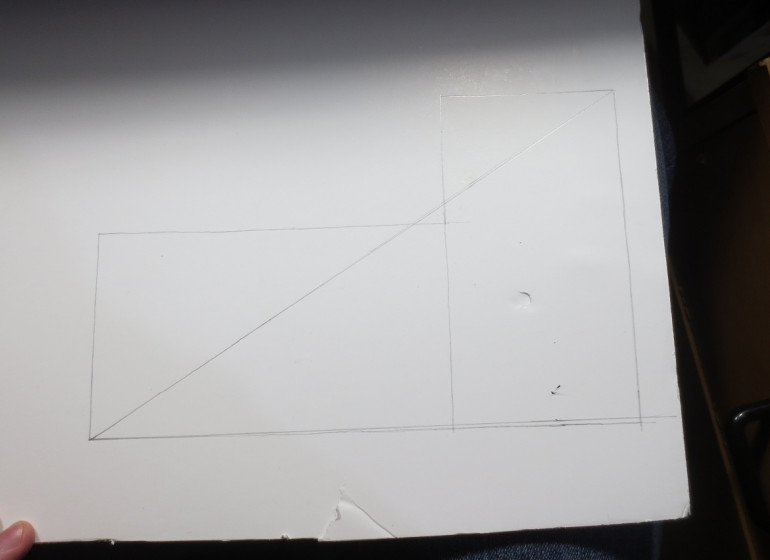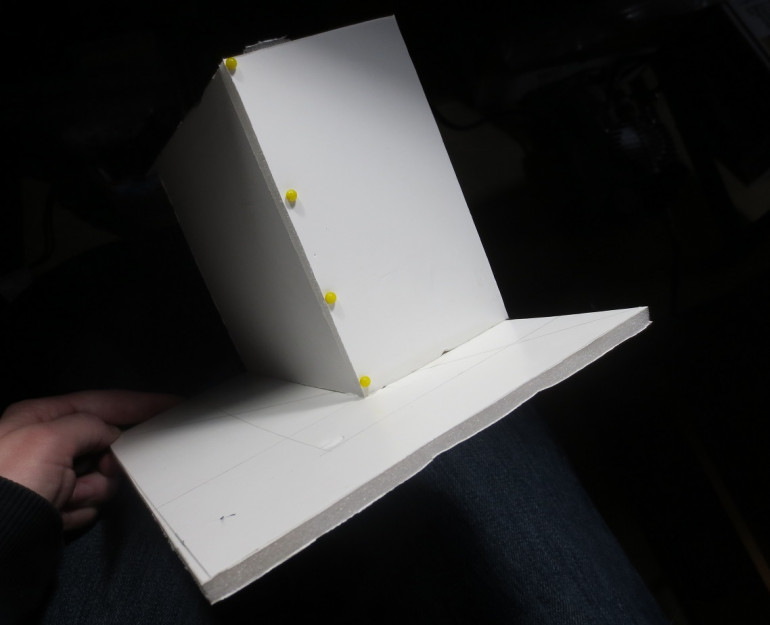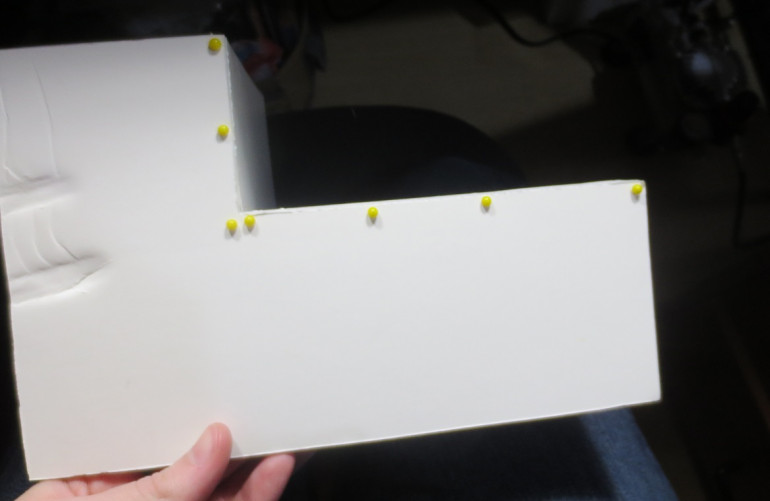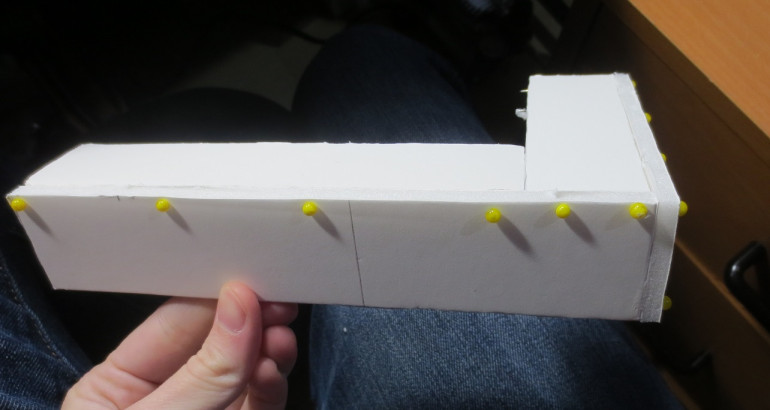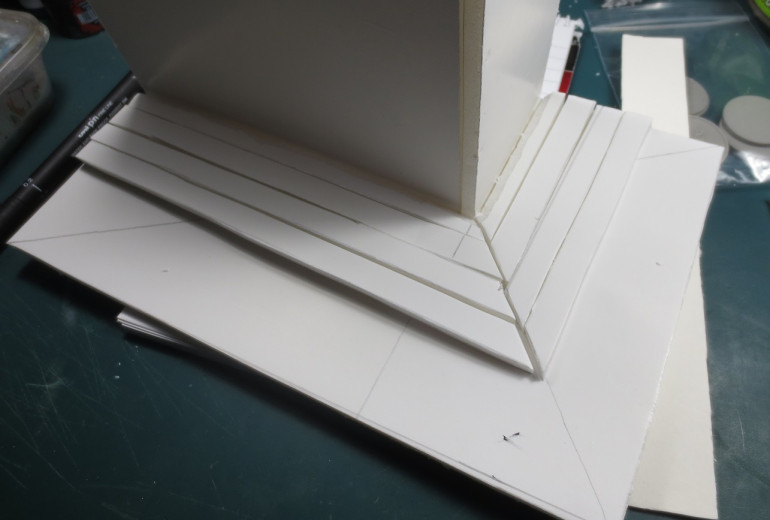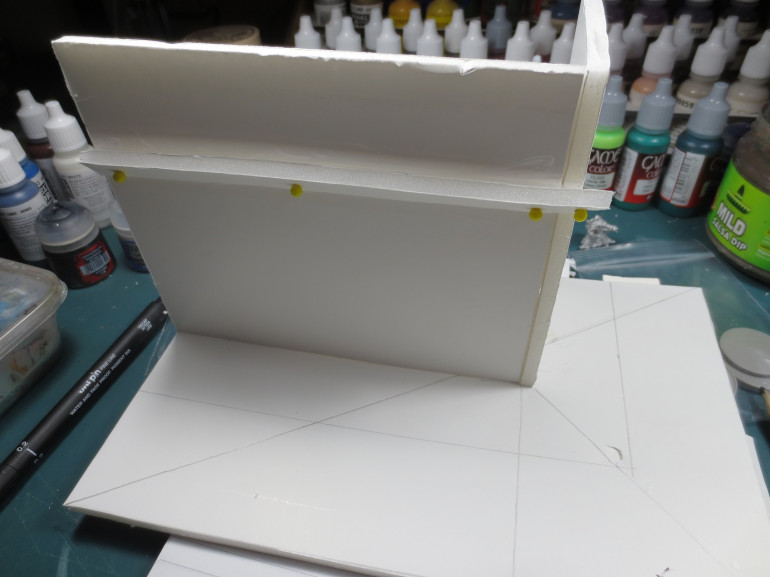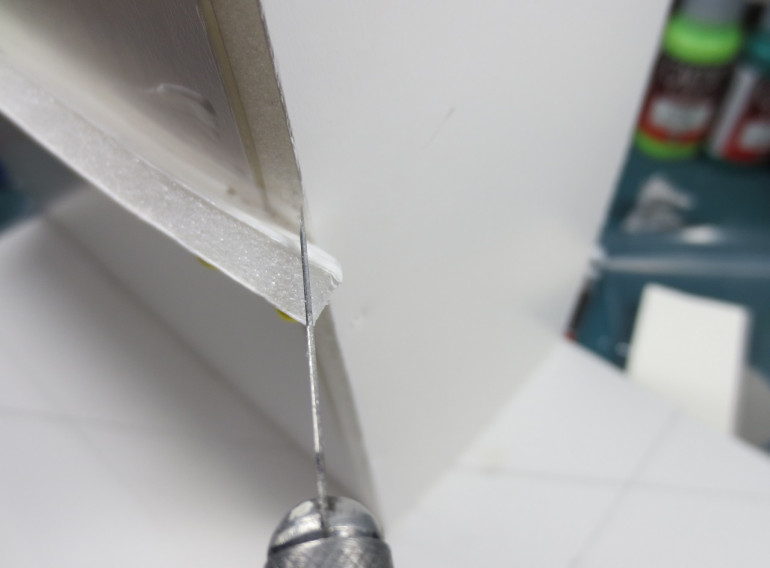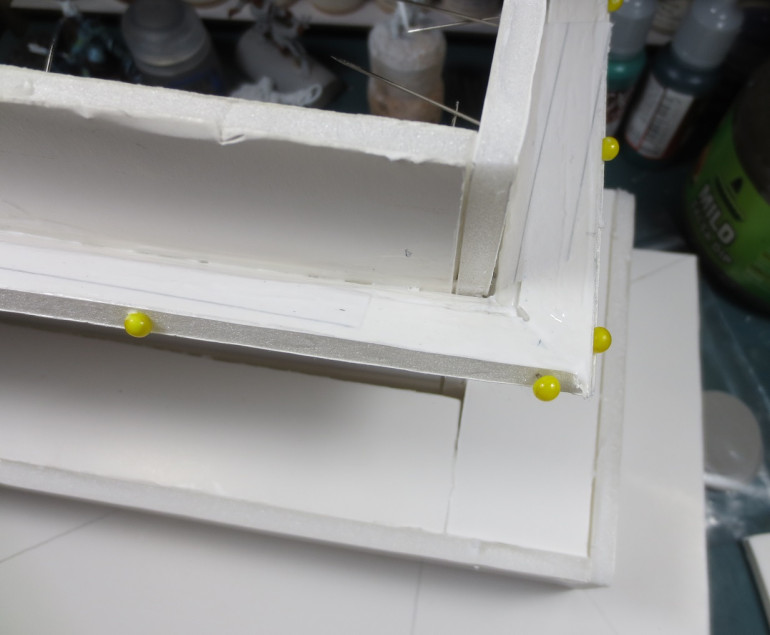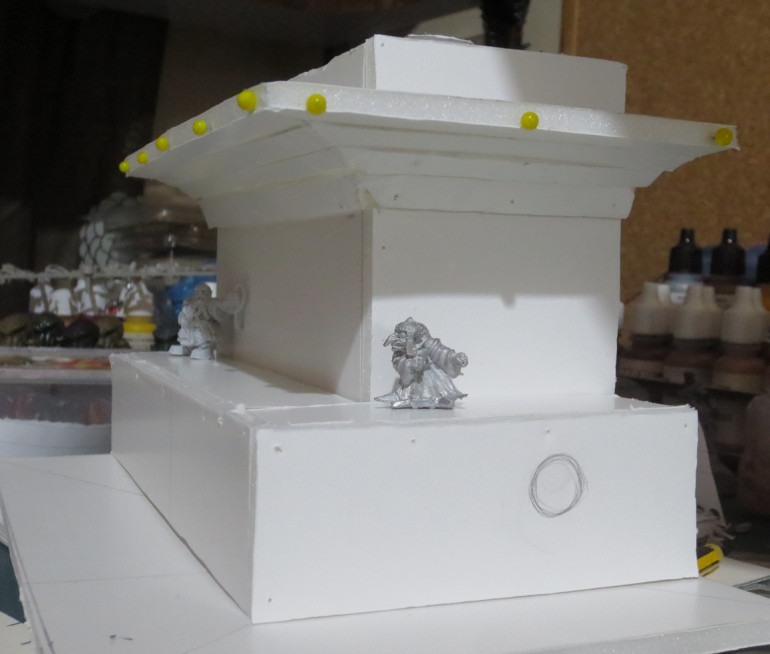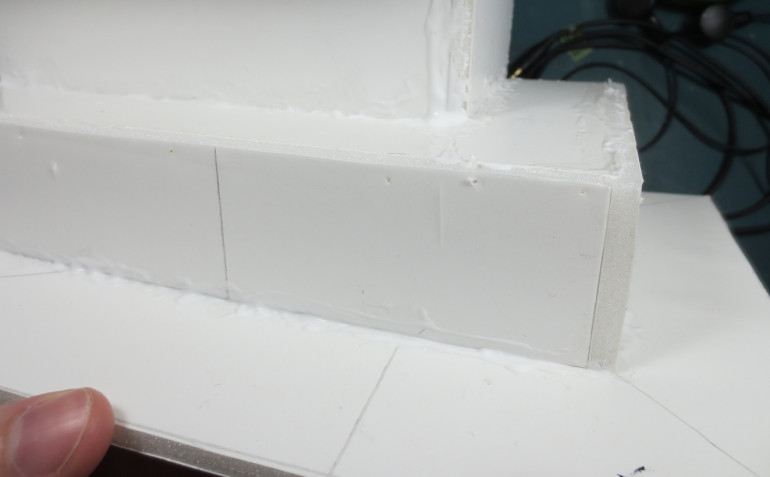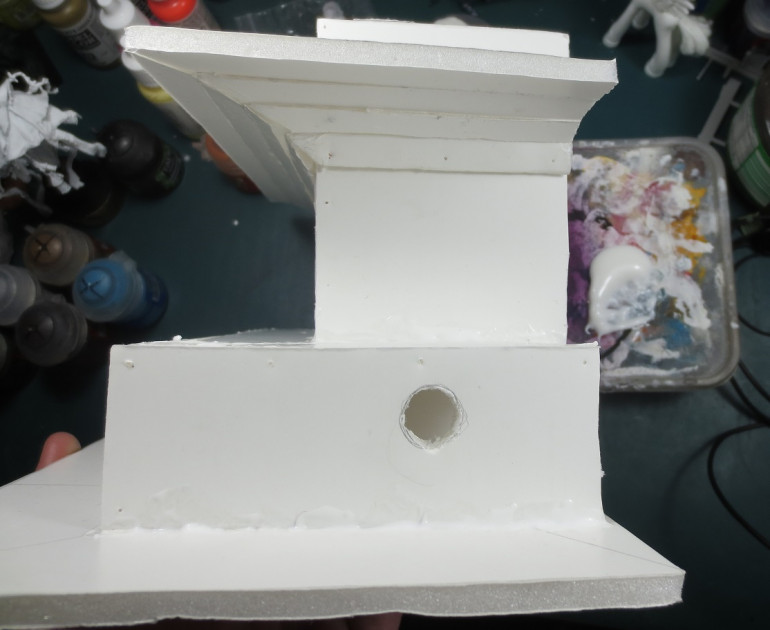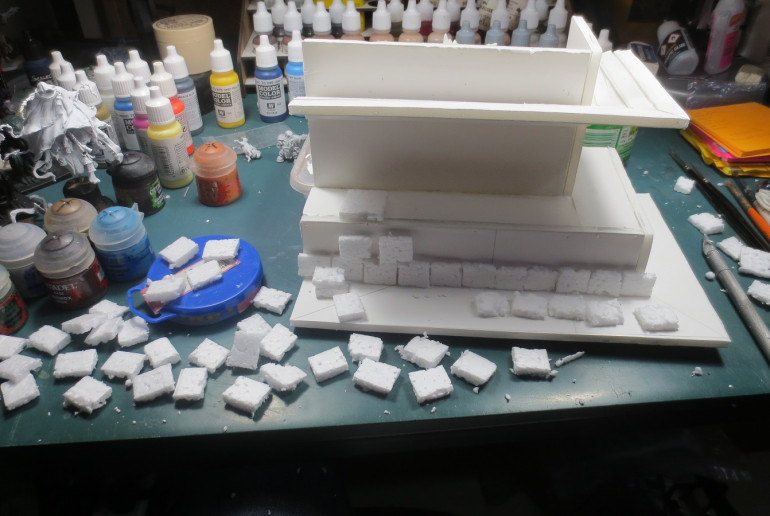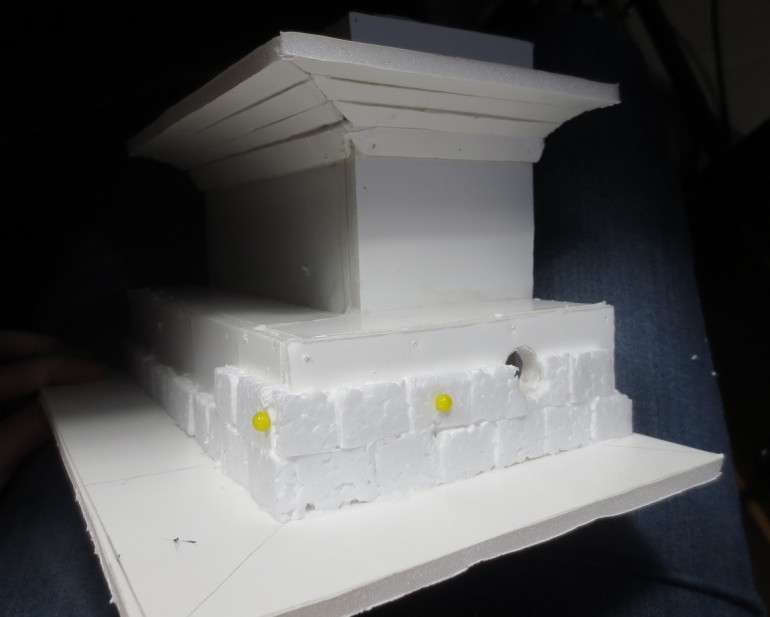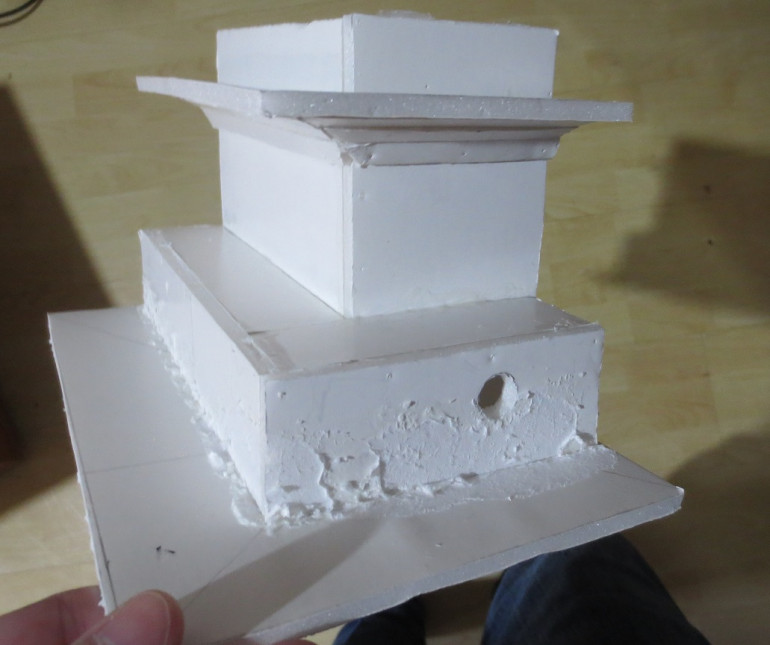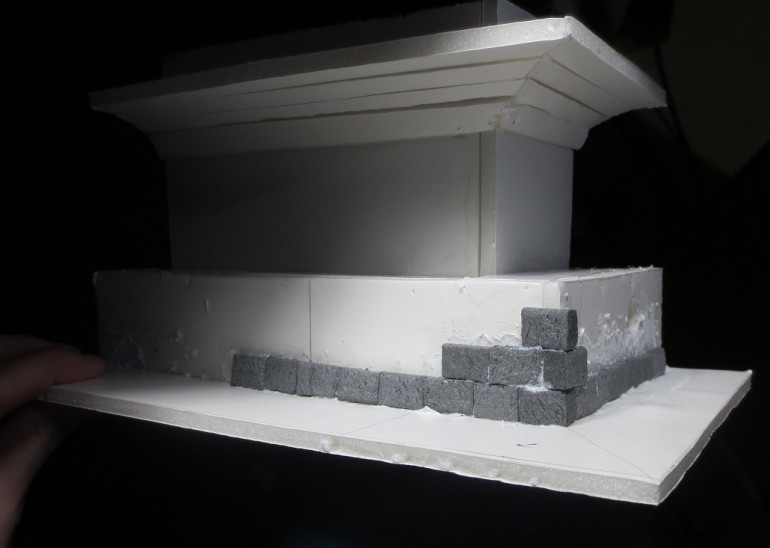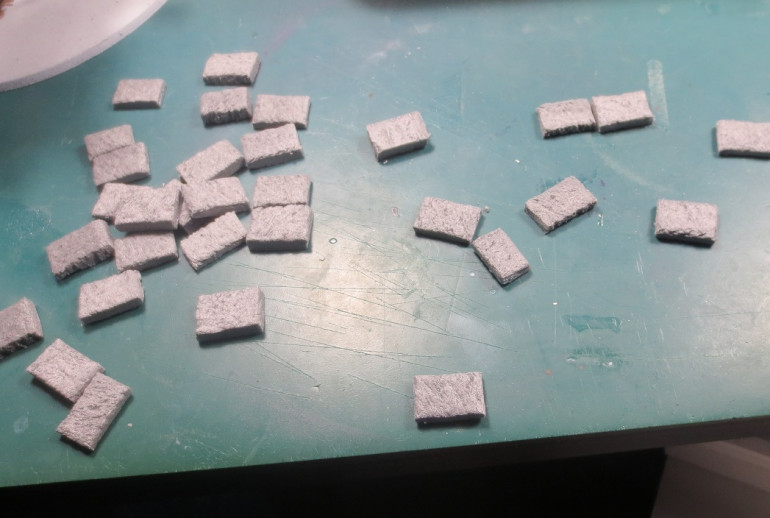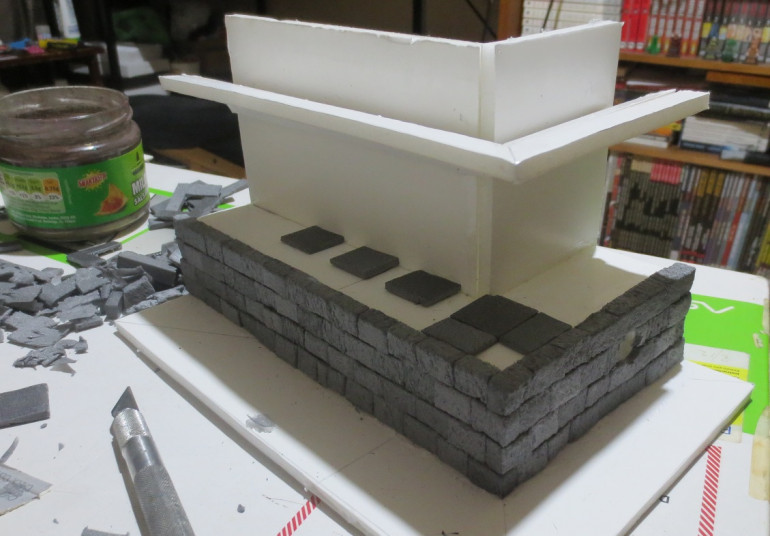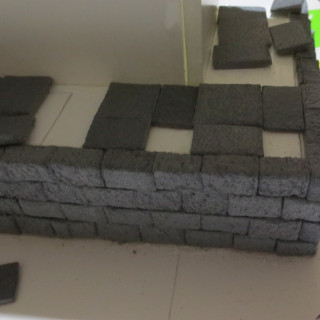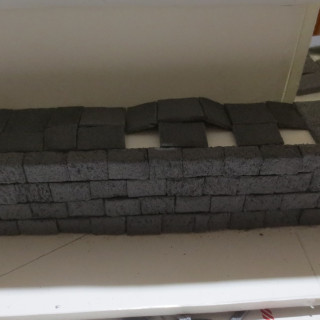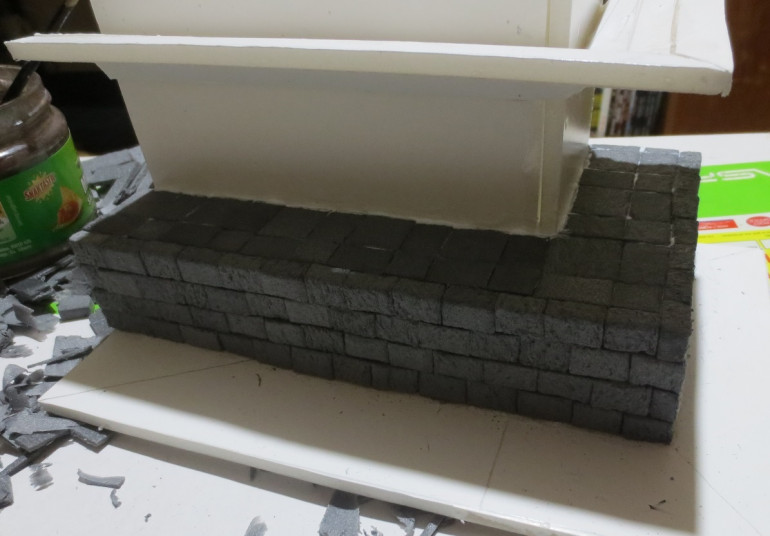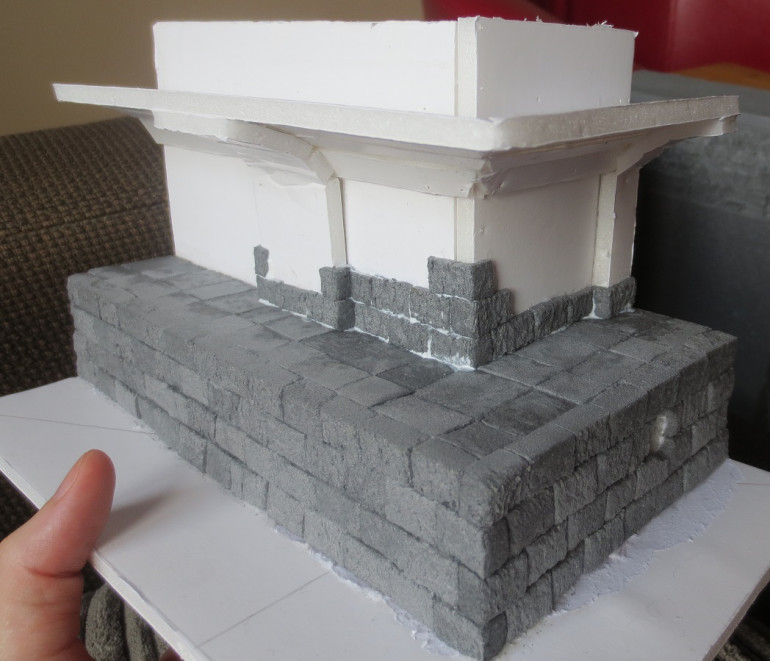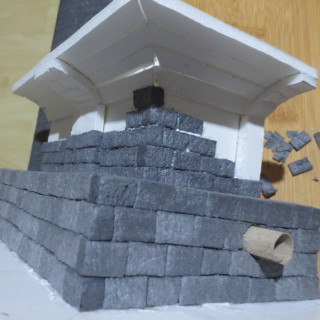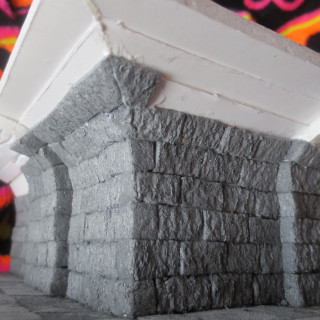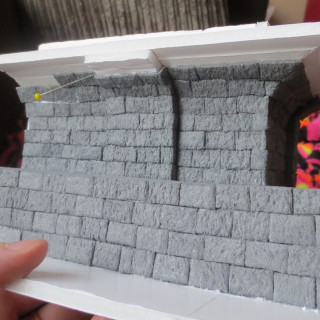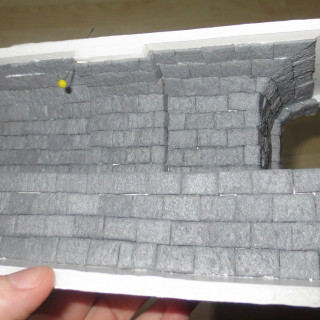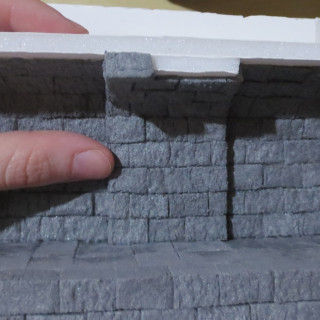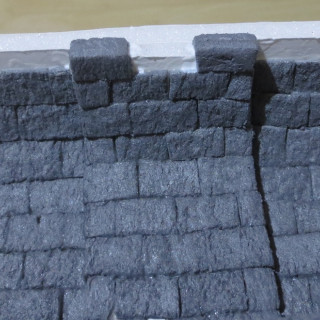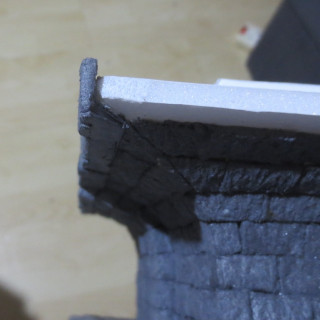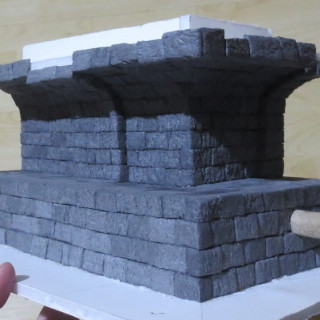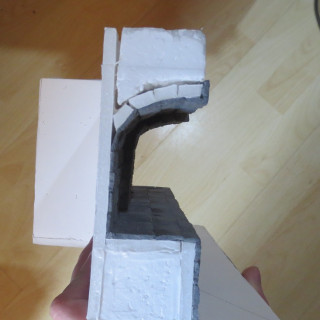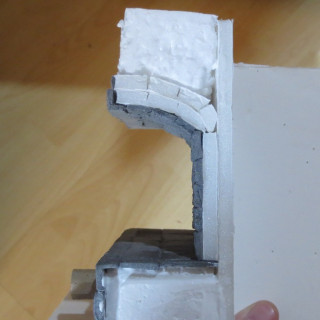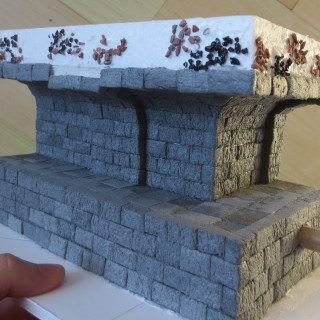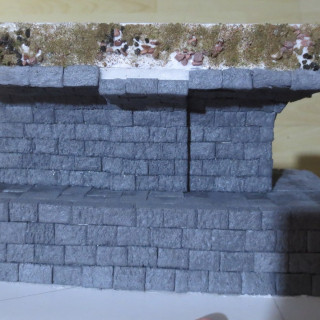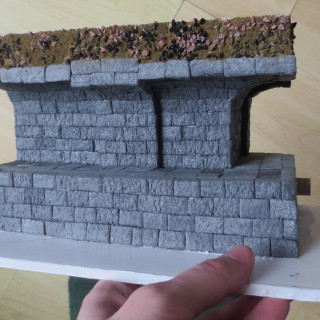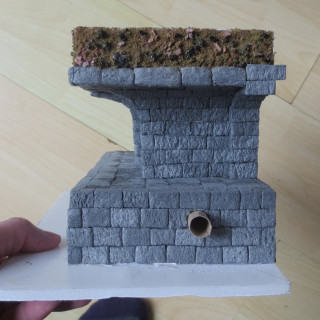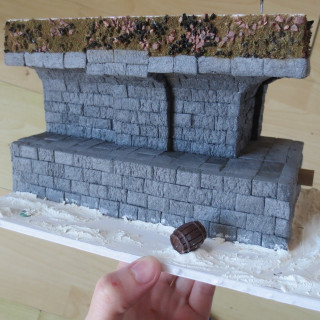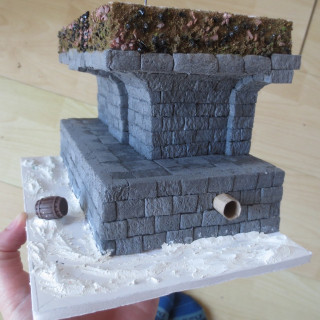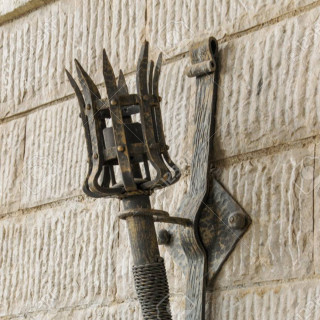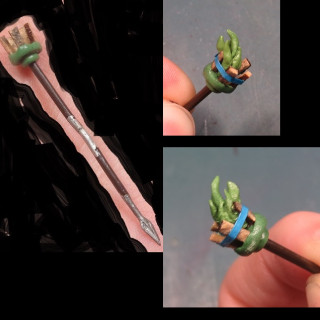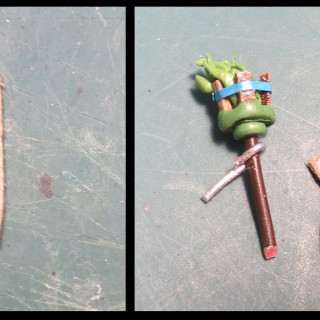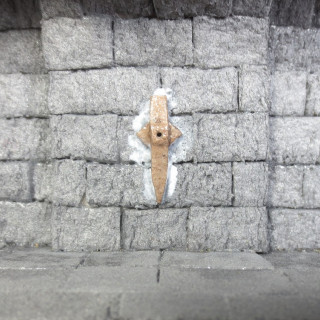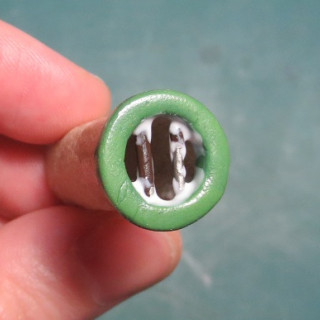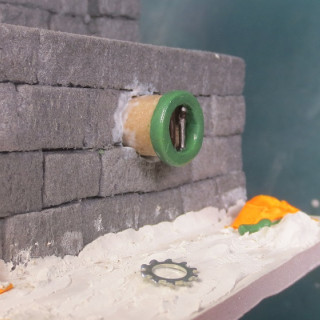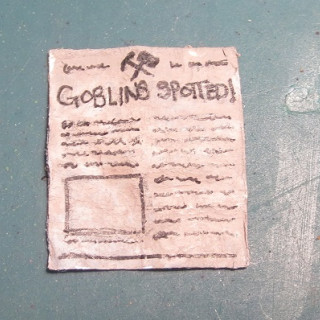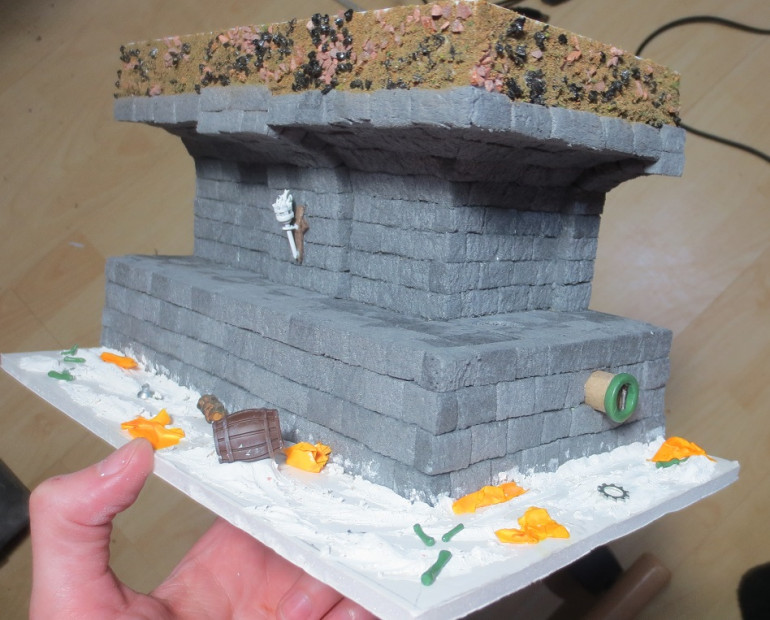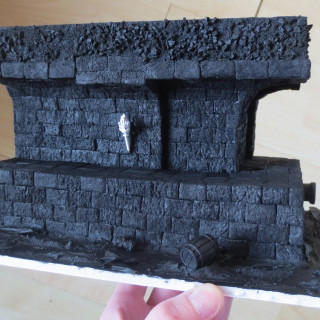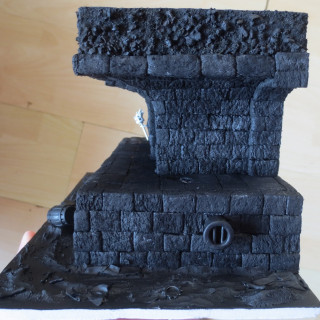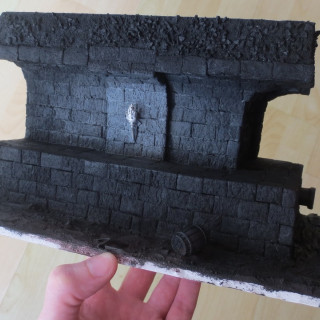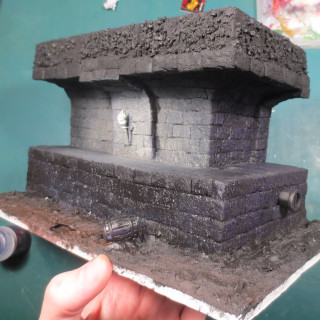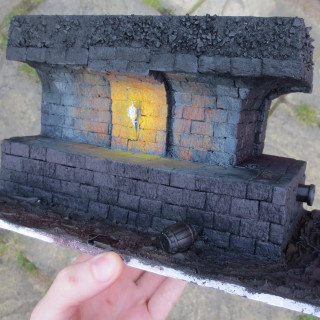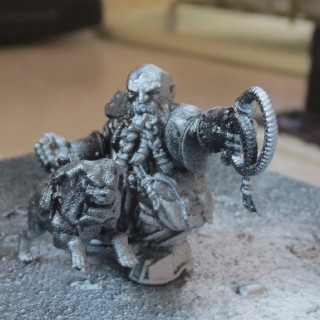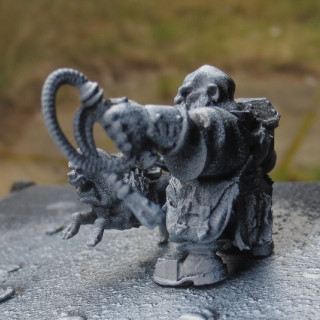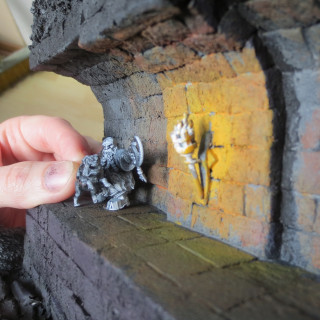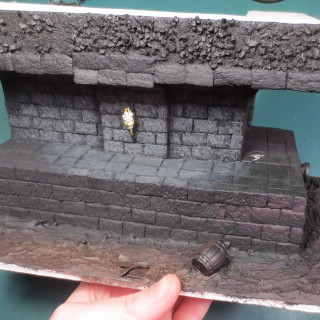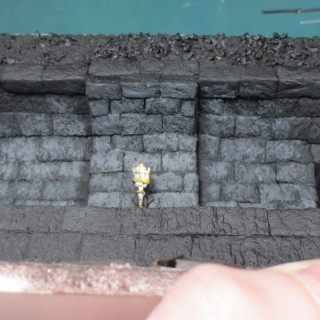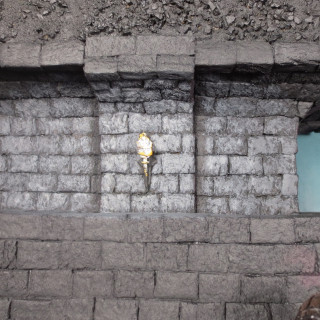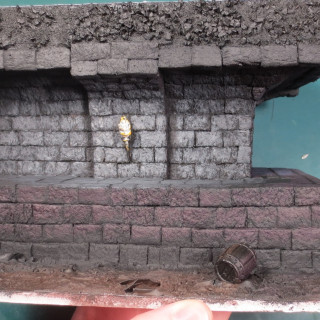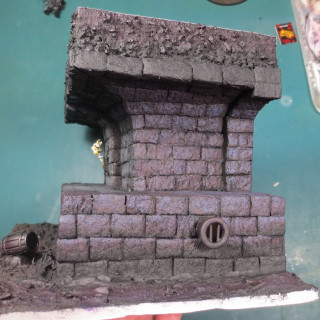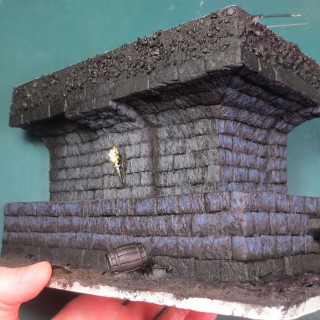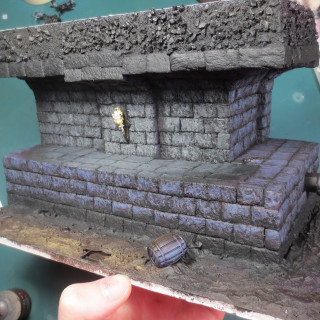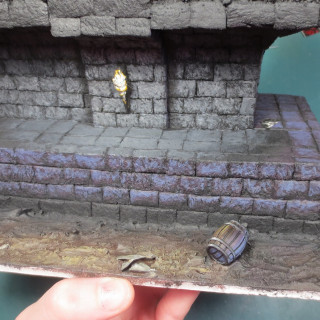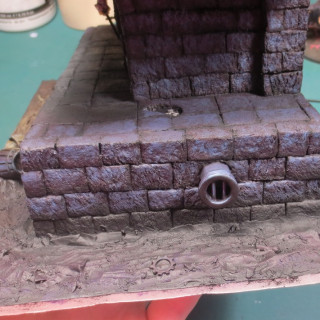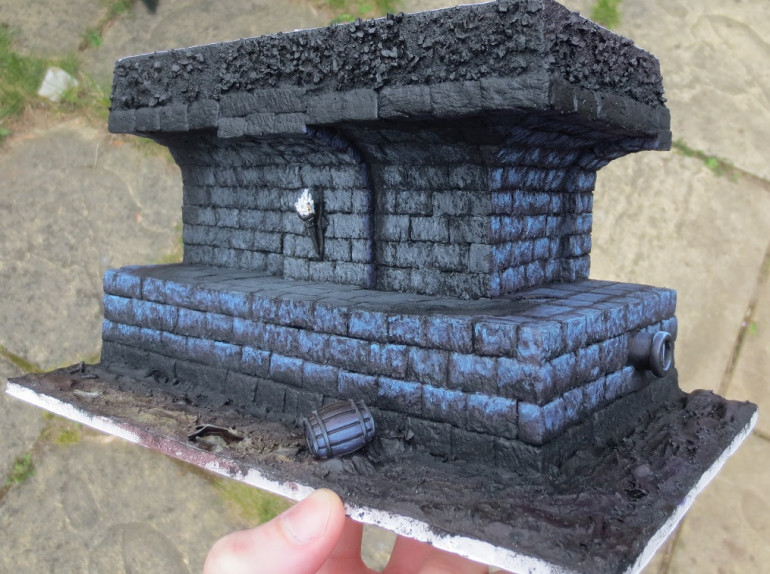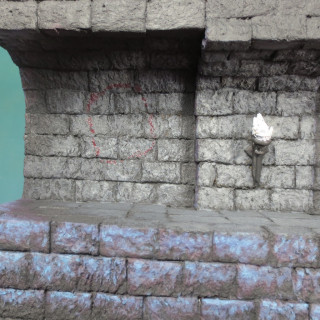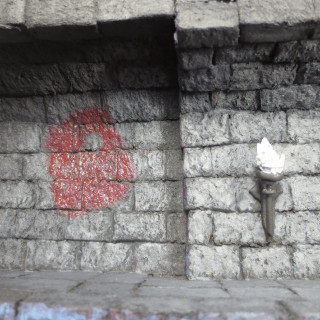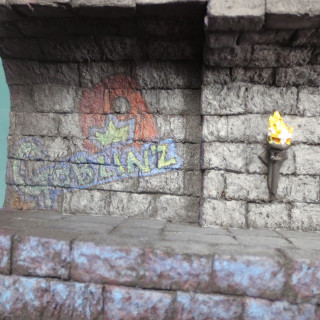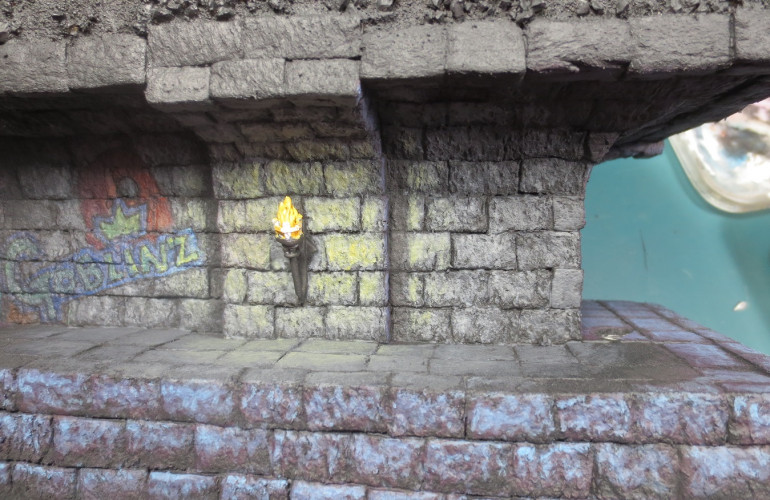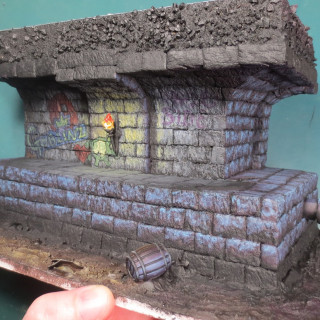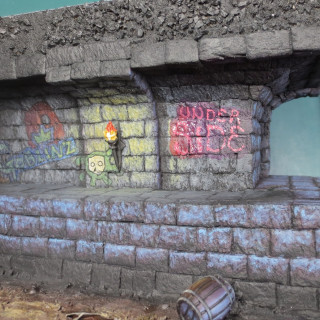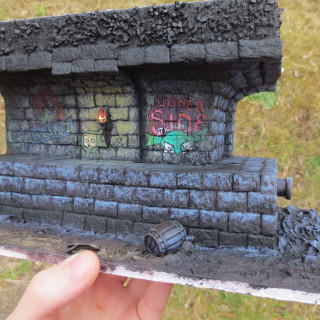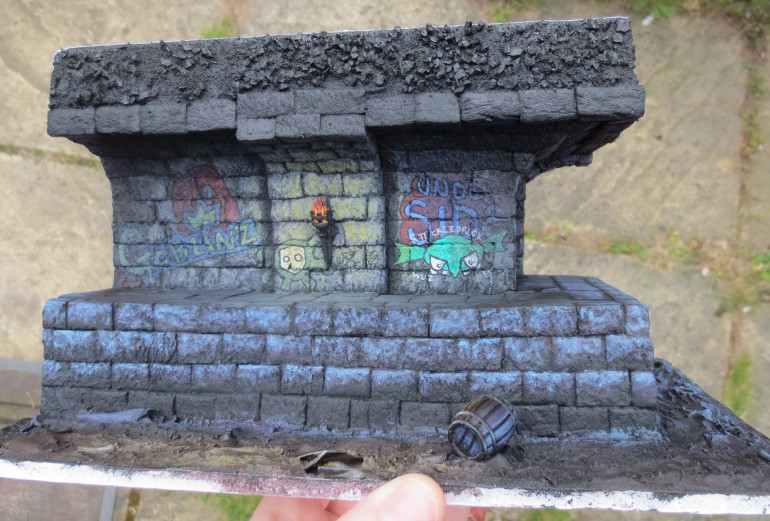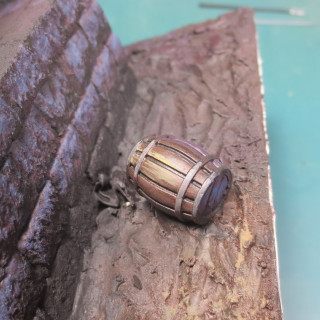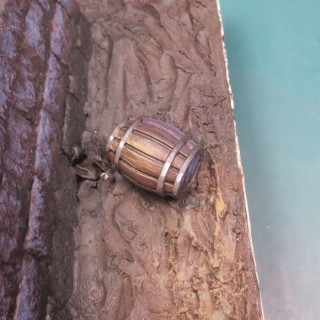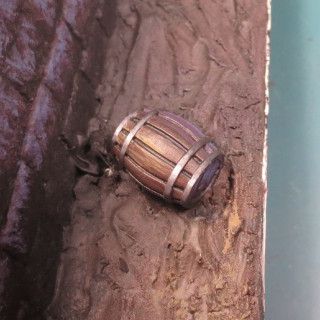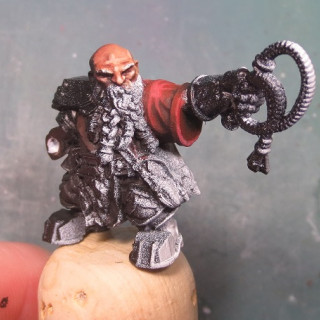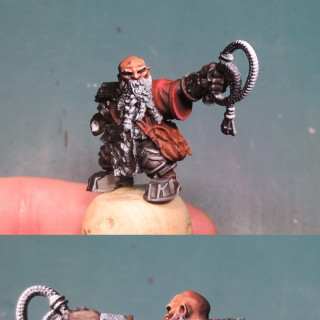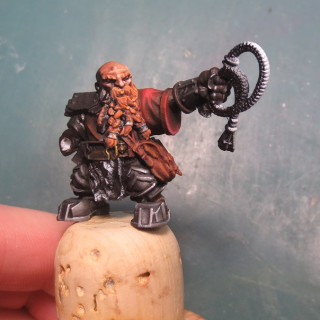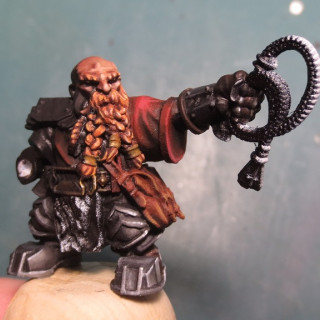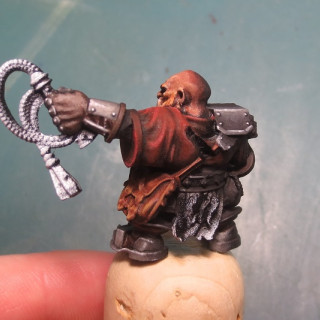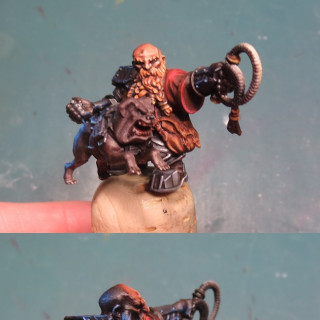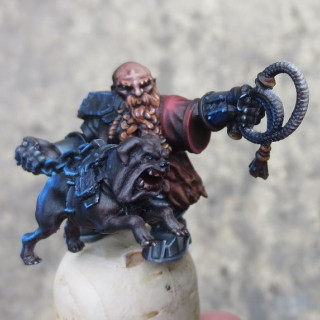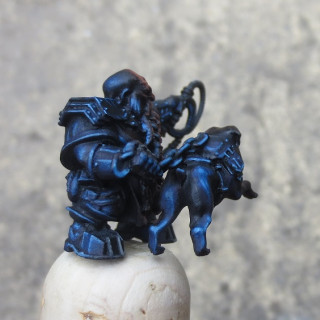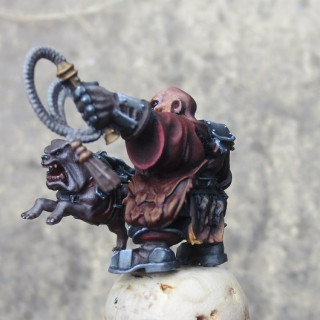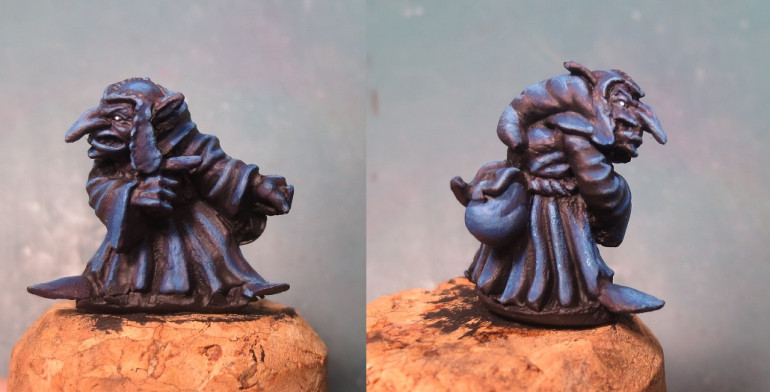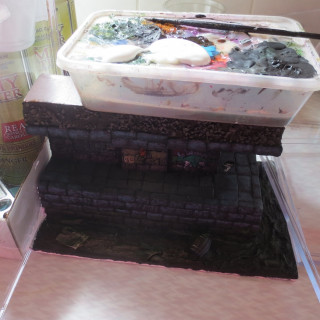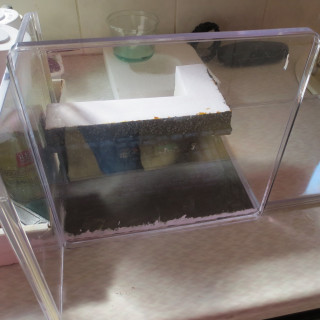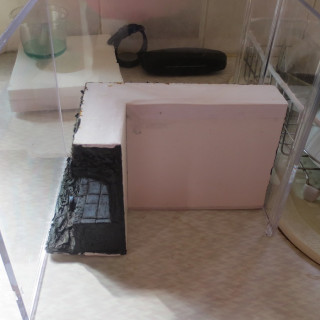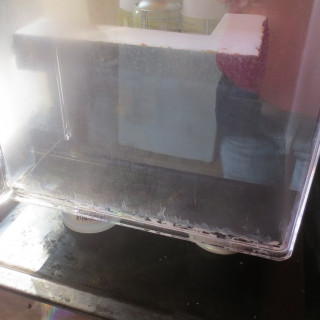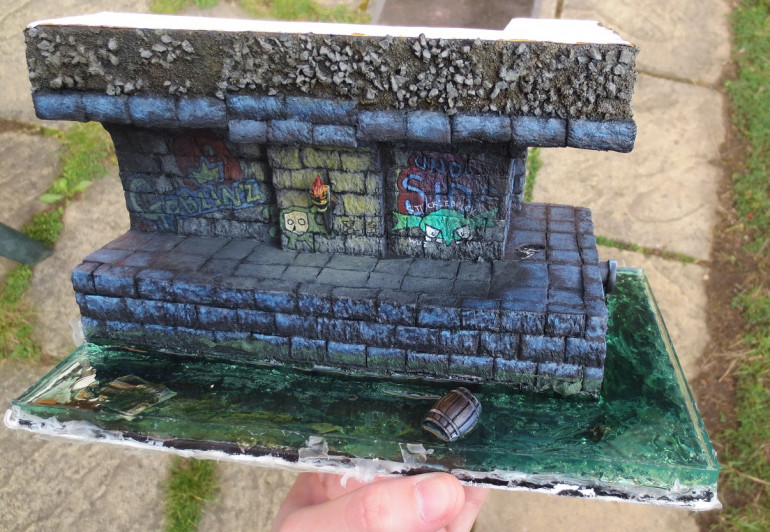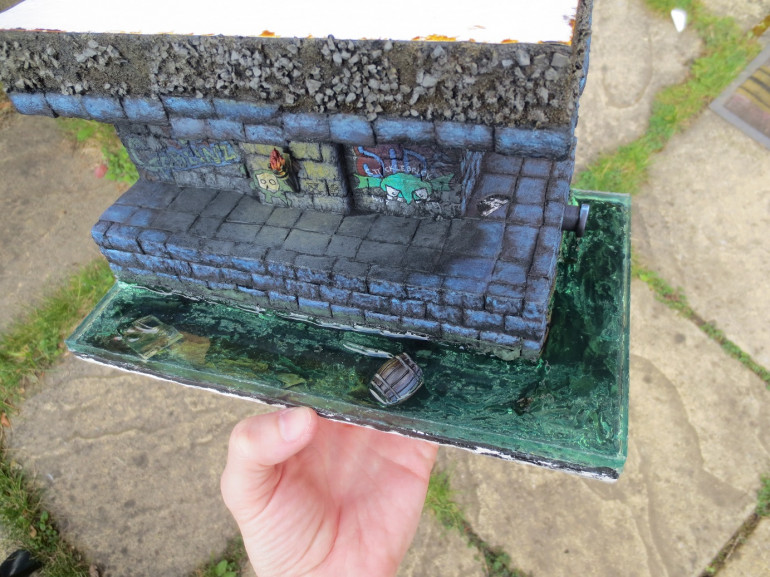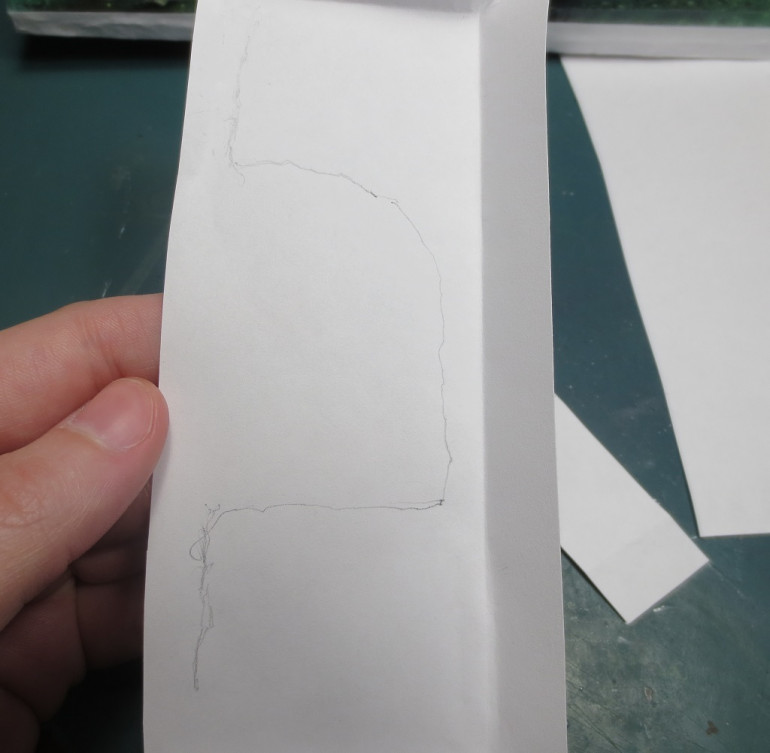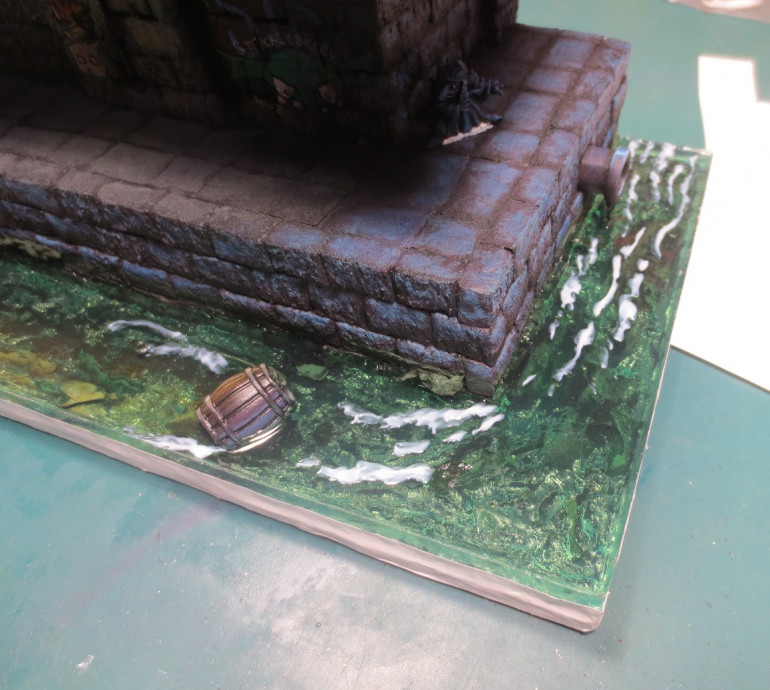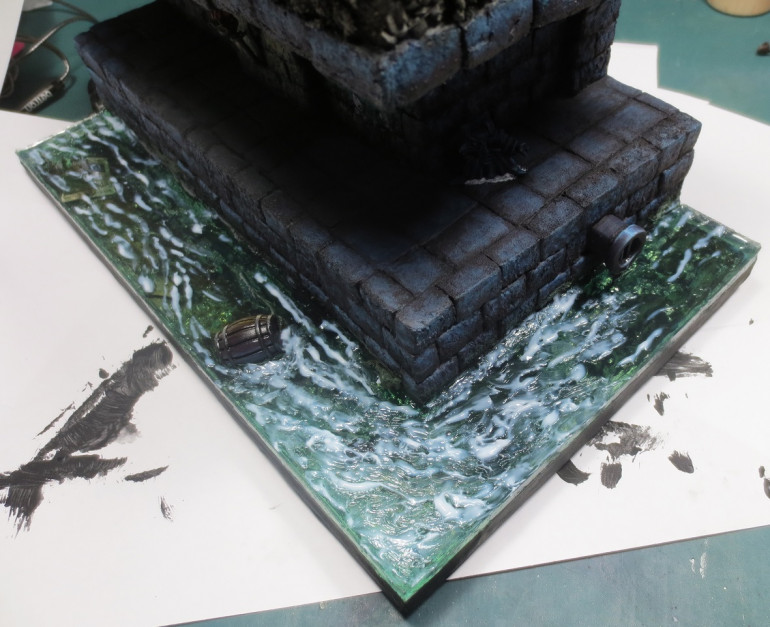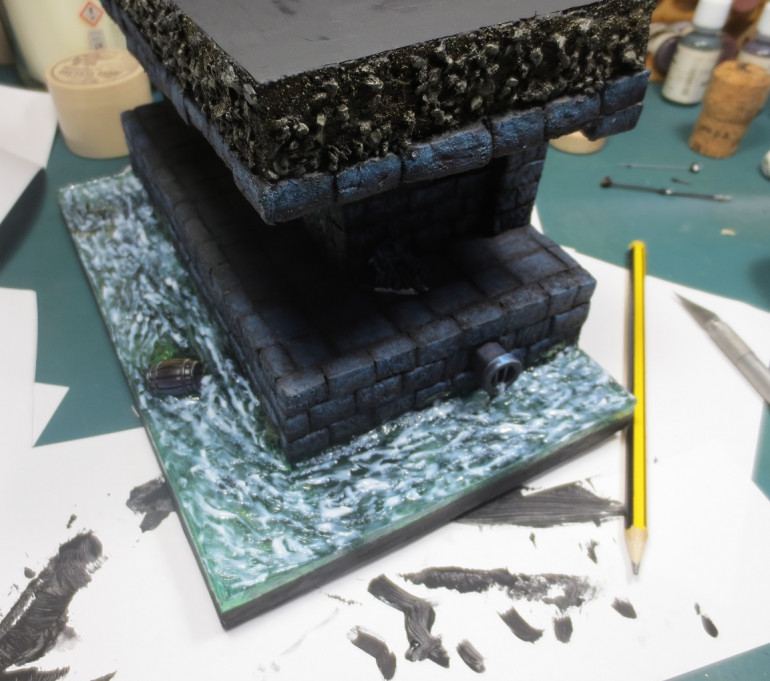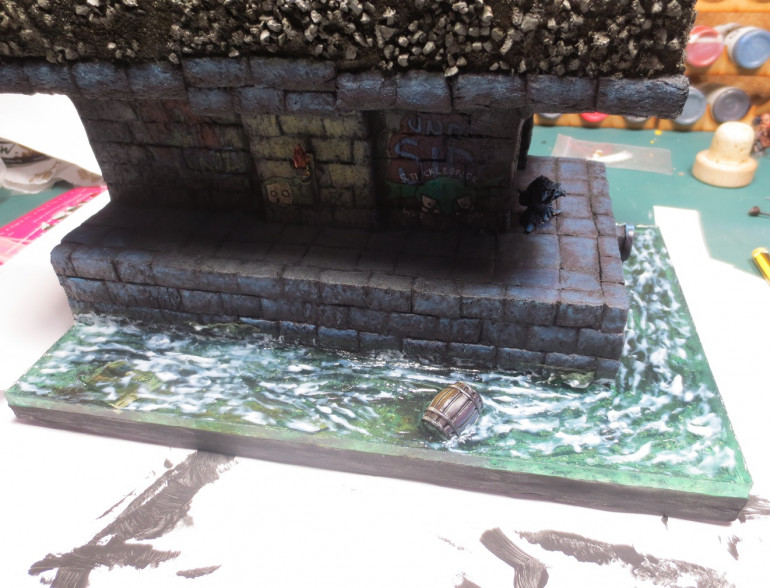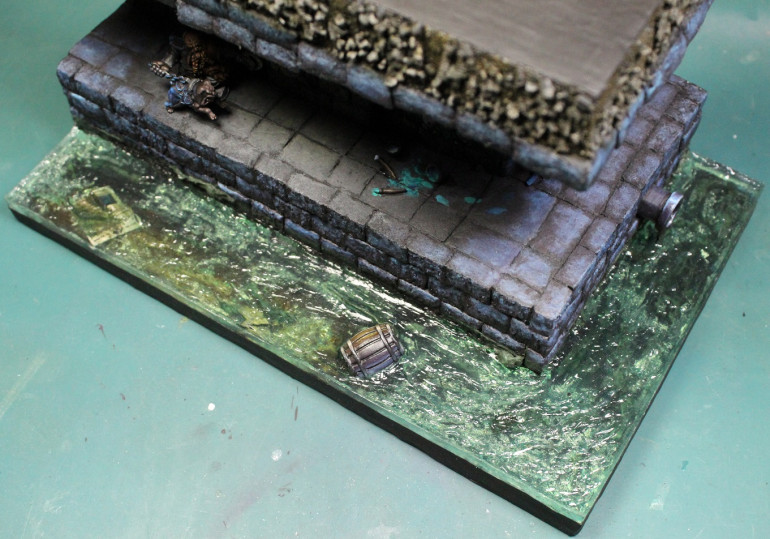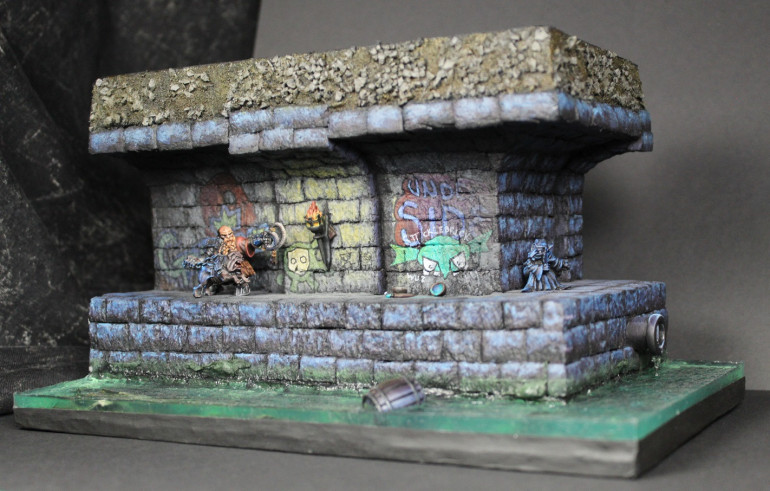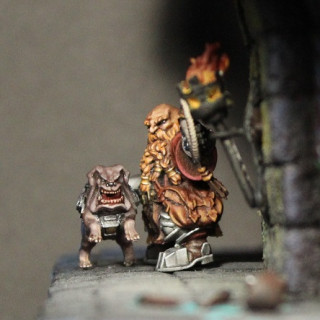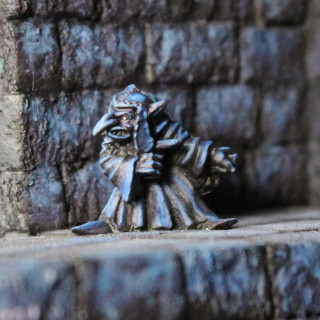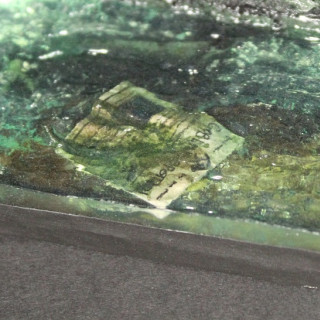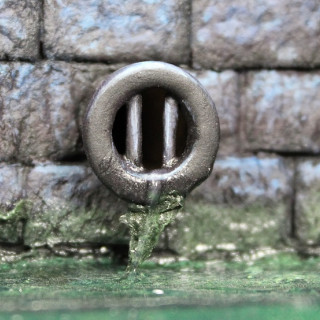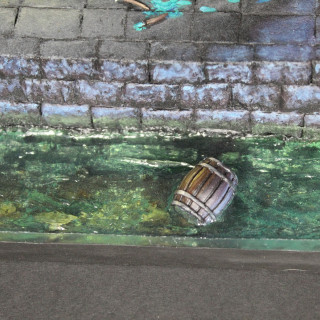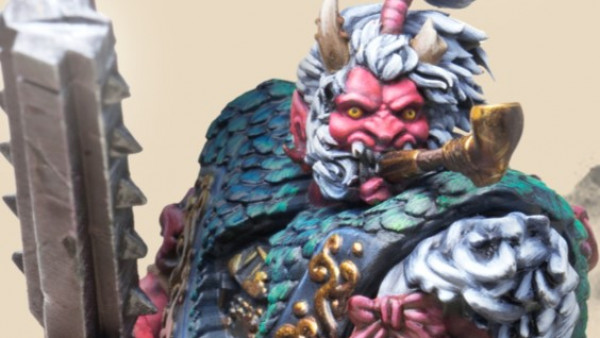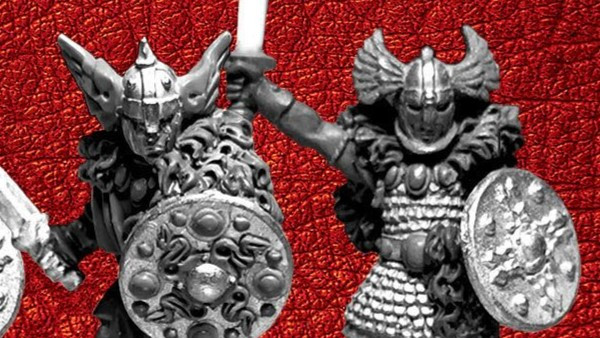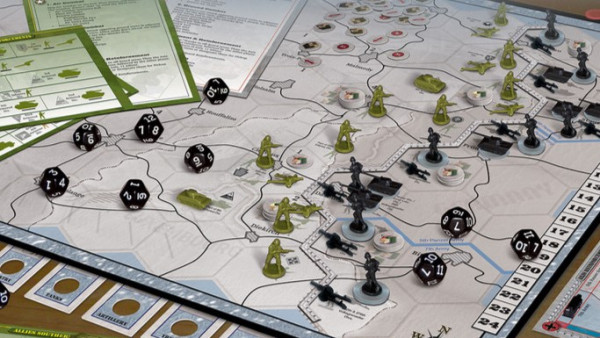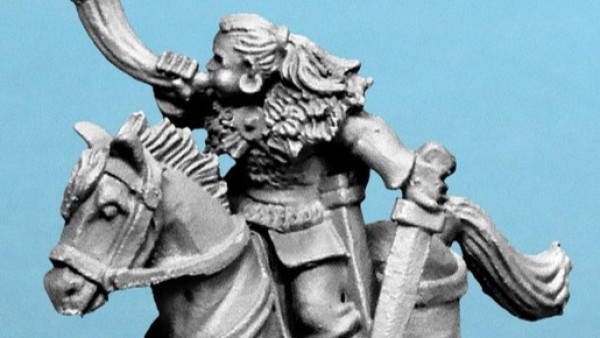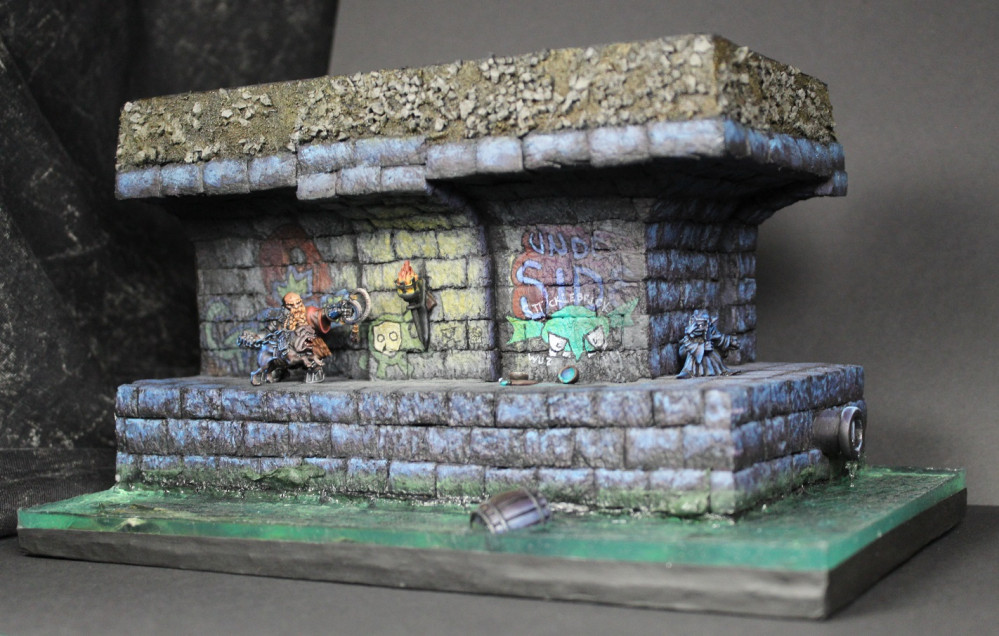
Brush With Death 2019 Entry
Recommendations: 265
About the Project
I view competitions as a way of pushing myself. When Mantic Games announced their 2019 Brush With Death painting competition, I decided to try building a diorama. Here goes!
Related Company: Mantic Games
Related Genre: Fantasy
This Project is Completed
Part 1 - Foam!!
In the past, I’ve only ever done scenic bases on miniatures intended for gameplay, so the idea of building a diorama was daunting, to say the least. Step one was browsing the Mantic webstore for (at least) two miniatures that not only looked interesting to paint, but also seemed like they would fit together in a world. After a while, I found them, and they demanded I build…. a sewer!
I had a basic shape for the diorama in mind, but the first step was to make sure I adhered to competition rules. The diagonal line through the “L” is the longest side, and it’s exactly 11 inches. The rules state the diorama can have a diameter of no more than 300mm or 11.81 inches.
(Please let me know if something here is off – I don’t want to get disqualified!)
I cut out the “L” for my base and added walls. I wasn’t sure how tall I wanted it to be, so in the end I just went for 5 inches.
Throughout, I’m using PVA glue and straight pins to make sure everything gets a good seal.
The next stage was constructing a walkway running along the back walls. I measured the wall lengths and, again, eyeballed a width I thought I would be happy with. In the end I gave myself a little extra room to work with by adhering the sides on level with the top surface, instead of beneath (which was the original plan).
As you can see, I didn’t attach the walkway straightaway. Instead, I drew a line between the wall corner and the far corner of the diorama and used this as a way of how I should shape the ceiling pieces. I want to try to for a curved sewer ceiling, and the only way I could see going about that was using long strips glued into the correct shape.
Part 2 - More Foam!!
To aid in making the shape I want, I cut the lower corner of the whole strip off, then glued and pinned it in place.
A little more was cut off on the end, staying in line with the guide on the base of the diorama and the wall corner.
More strips were glued on in the same manner. I also glued a strip of paper over the join to strengthen the connection.
Finished. I put the miniatures in place to see if I was happy with the shapes and empty spaces. The empty space is probably what I eyeballed the hardest, as I didn’t want to the piece to look too empty.
While it does look a little empty right now, I intend to bulk it out with sewage, bricks, and maybe some supports.
Part 3 - A Little More Foam
For the next step, I glued down the walkway. Although you can’t see it in the picture, the base piece of foam was warping a little, so I made sure to slather on the glue and pin really well in an attempt to straighten it out.
I also cut out a hole where I think I’d like a sewer pipe to emerge out of the walkway.
Bricks! - Attempt One
A part of Sunday was spent cutting bricks from foam! I decided to build from the base upwards, so that I could make sure the brickwork was seamless. In my head, I saw one of two options: rough sewer crumbling into disrepair, or very-well constructed sewer (if not exactly tidy). I decided to go with the latter, as in my head I’m imagining a goblin fleeing through the bowels of a dwarven city.
And, as we all know, dwarves are very good at stonecutting and construction.
Unfortunately, I used the wrong kind of foam! My SO pointed out that the foam beads would only look more obvious once I’d painted and washed the brickwork. If there was one good thing to take away though, it’s that the brick layout looks good.
So, off it comes, to make way for the new high-density foam even now winging it’s way toward me.
Bricks! - Attempt Two
The high density foam arrived, so I’ve been cutting and shaping bricks for the past couple weekends! I decided to take the longer, more work-intensive route of cutting out individual bricks; by cutting from different parts of the foam block and swapping bricks around, I was able to create an uneven, worn effect that I really liked.
The first wave – it took a lot more bricks than this.
Base of the walkway done, at which point the overall effect of different brick textures really comes through. Hopefully, that will do most of the work when it comes time to paint and weather.
I played around with a couple patterns for the top of the walkway. The only thing I really knew is that I wanted it to look smoother than the sides.
I started with large flagstones (larger than those in the picture), which looked too out of scale with the miniatures. I cut them down to the size you see above, with the plan of filling the surface with them.
After shuffling around differently-sized pieces for a bit (as well as a Sunday nap), I hit upon the above pattern. Hopefully it will toe the line between utilitarian and boring.
Done!
Next I’ll be continuing the brick pattern up the walls. I’m not sure how I’ll achieve the join on the arch, but it will probably require some Googling for reference pictures.
Walls
With the walls, as I did on the walkway, I started from the corner and worked my way outwards in each direction.
The most difficult part was navigating the smooth transition of wall to arched ceiling. As the angle bent further and further from 90 degrees, I had to switch away from bricks that wrapped around the corner and instead create corner pieces using two flat surfaces. Although I’m not sure it fully supports the illusion of 3D bricks, the eye will probably pass over them when the diorama is fully painted.
You can see where I’ve used drawing pins to hold bricks in place while the glue dries (laid above the brick edges, not pushed through the foam). I used this a lot on the corner pieces of the supports as the roof began to curve, in order to lessen the gaps between bricks. Normally, these gaps would probably be filled with mortar but I wanted to create the effect of well-fitting stonework.
The final layer is what (I hope) really sells the illusion of brickwork.
Again, I had to fake a corner piece in order to continue the lines established on the curve by earlier layer of bricks.
The next step will address the empty space above the tunnel as well as the open ends on the walkway.
Above the Tunnel
As a first step to filling above the tunnel, I cut a piece of my low density foam to fit the space. Once it had been fit as closely as I could make it, I began gluing two kinds of basing materials as well as dirt.
At one point in the middle of this process I also cut out the final bricks and glued them into place.
Populating the Diorama
With all the foundations in place, it was time to start filling empty space. I plan to attempt a resin pour alongside the walkway, but adding random detritus to the flow will help make it look like a sewer. So – Milluput piles and a barrel from the Mantic Dungeon Sage Furniture Set!
The diorama also needed a light source, so I set about sculpting a torch and wall bracket, using this picture as a rough guide:
Finally, glue the wall bracket in place, sculpt the end of the pipe that’s been lurking at the edges of these WIP pictures for a while, and draw a newspaper to throw in the sewer flow.
(The newspaper was originally one of the paper labels that come on the ends of tea bags, painted over and then drawn on.)
Ready to Prime and Paint
About to prime the entire piece using black paint (I’ve been told a spraycan primer might melt the foam bricks) and then it’s ready for paint. I decided to prime the wall torch before mounting it with PVA – I wasn’t sure I’d be able to reach all of it after it was up.
Primed!
After about two hours of going at it with a too-small brush (new item to buy: large brush), the diorama is primed and ready to start receiving paint. This is about where I hoped to be in terms of timeline: I have a month and a few days to paint up two minis, paint their surroundings, pour resin, and finish edges.
I’ve been so focussed on building that it might be a little difficult to switch gears. Paint, paint, paint!
A Week of Missteps
As the title suggests, the week was largely a bunch of mis-steps. Between other things, I tried several times to lay down the beginning OSL work, so as to be ready for more detailed jobs during the weekend.
Each attempt felt worse than the last.
I was quite happy with the first attempt, but after looking at it I wasn’t confident in my ability to convey the idea of graffiti on the walls in such low lighting conditions. The second picture is my attempt to brighten everything up. However, the paint wasn’t acting how I wanted or expected on the foam, an impression that was confirmed when I went in and added yellow.
I wasn’t able to get the kind of control I wanted over the paint – I couldn’t drybrush and whenever I added a little water, it seemed to soak into the foam.
After a few days of this, I took a break from the diorama and primed the minis.
The OSL priming was looking good, but holding the dwarf in the diorama only confirmed how unhappy I was with the lighting I’d done so far.
After some poking around the internet, I decided the foam probably wasn’t prepped correctly. So, I added a few layers of a cheap acrylic paint over the work I’d done previously, then varnished it using Army Painter Anti-Shine. To my relief, the spray propellant didn’t melt any of the foam.
Painting (At Last)
The moment I applied paint on top of the varnish, I could feel the difference. The paint stayed where I put it without spreading across the foam or disappearing into it. I set about applying layers of Reaper’s Regal Purple to the darkened areas and a mix of black and Citadel’s Stormvermin Fur to the areas around the torch. I gradually layered this latter portion up using increasing amounts of Citadel’s Administratum Grey.
After I’d brought up the lit portions of brick, I went back to work on the dark parts. I highlighted the Regal Purple using a mix of Regal Purple with Citadel’s Lothern Blue, then unmixed Lothern Blue.
The final effect outside, in natural daylight.
Adding Graffiti and Some OSL
The next part I wasn’t so sure about, but when my SO suggested I have the goblin doing a little sewer defacement, I knew I couldn’t resist trying. I set about adding a little colour to the diorama walls – if I didn’t like what came out, I could re-do the walls without much difficulty (albeit for an unexpected FOURTH time).
So far so good – not hating what I see. The process for graffiti was basically:
- Draw some things on paper
- Decide I hate them
- Ask my SO to draw some things on paper
- Begin with an outline, then fill them in with block colour
- Highlight toward the torch, shade further away
After finished the first wall, I decided to add the OSL from the torch. This was partly to keep colour balance in mind – I want it to look like a very yellowy light, which will affect which colours I pick for the graffiti and how I highlight it.
This was achieved by adding thin layers of Citadel’s Averland Sunset in a rough circle. I added multiple layers on the portions of wall closest to the torch, in order to increase colour saturation.
That’s about where I ended it Saturday evening. Sunday was spent adding more graffiti. You’ll see some portions come and go as I decide I don’t like them.
The last picture is where I ended on Sunday afternoon. I think I’ll change the pink colour used for the ‘UnderSide’ tag – I think the warm colour pulls too much away from the picture of the goblin.
Mid-Week Update
Not much progress this week – although I have managed to swap the pink graffiti colour for a blue. I think it works a lot better. Still visible and obvious, but not quite so attention-grabby.
Also, three NMM progress pics on the barrel I didn’t post with last week’s update.
Next it will be time to start on the actual miniatures – exciting stuff!
Long Time No Update! - The Minis
I had a schedule for this diorama. One item not on the schedule was a nasty case of tonsillitis, but it forced itself in there anyways. Bye bye, Week 2 of April. About the only progress I managed was the post below (switching pink graffiti paint to blue).
However, after a week of bedrest, 10 days nomming penicillin, and a few days eating solid food, I was back at it in a big way!
I planned to have the dwarf in strong OSL, so I started with the face and worked my way down onto the arm extending into the light. Colours used include the Reaper Fair Skin paint triad as well as Reaper Carnage Red.
I essentially followed the lines laid out by my zenithal priming by blending everything down into dark browns, then black. Then I began painting the dwarf and his faithful hound from the opposite direction, using Reaper Regal Purple, Vallejo Prussian Blue (my newest paint), and Citadel Lothern Blue to achieve the glowing shadow effect above.
While the dwarf took me around three painting sessions (plus numerous adjustments – you’ll notice the highlight on the dog’s right hip shift between this post and the next), the goblin was done in two hours! By far my fastest paint job so far. I love this glowing shadow effect – it’s fast and gives a nice effect.
With the miniatures done, it was now time to face the great unknown: resin water effects.
The Resin Pour
This was my first water effects resin pour. After a lot of research, I settled on polyester clear casting resin from Swindon Watersports, as well as green and black dye from the same company.
By complete coincidence, I’d recently decided to throw out a lightbox that wasn’t doing it’s job properly. For whatever reason I decided to keep the plastic panels. They turned out to be large enough for my purposes (yay hoarding!).
I lined the edges of the foam base using Milliput, waited for it to cure, and then repainted the bottom of the sewer. I also switched the blue for green along the bottom.
The next day, I started setting up the plastic (this was Tuesday, three days before the entry was due. I was sweating a little). It turned out to be a much longer process then I anticipated. Each side needed to dry separately before adding the next. Similarly, I used two kinds of glue: PVA/Elmer’s Glue along the edges of the diorama, and superglue on the plastic itself.
Much of the construction took place using the edge of my sink and a box of spray paints for support.
Before moving on to the actual pour, I re-upped the PVA along the inside so that the resin wouldn’t leak. This turned out to be the first of two mistakes I made during this pour. I should have dammed on the outside of the diorama. As it was, the glue created gaps between the bottom of the resin and the top of the diorama.
As you can see in the above picture, I balanced the entire thing on top of a baking tray. It was the only thing I had on hand to catch the resin if it leaked.
And, roughly twenty-fours later…
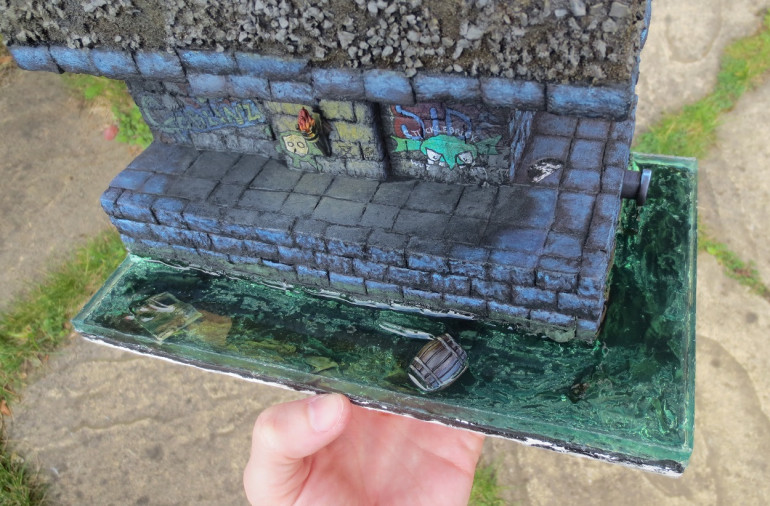 After the pour but before covering it up to cure, I used tweezers to drop 'seaweed' clumps into the water flow
After the pour but before covering it up to cure, I used tweezers to drop 'seaweed' clumps into the water flowAll in all, not bad for a first resin pour. Here, I made the second mistake: I poked the resin. Bam: fingerprint. After I’d cleaned up the edges, my SO and brother in law each proceeded to do the same thing. What is it about fake water that’s so alluring?
My third mistake took place the previous day. I’d forgotten that the rough texture sculpted into the sewer bed would create bubble problems – I should have used an awful paintbrush to scoop and smooth resin onto the base before proceeding to the actual pour. I think I was just too excited. Also, I performed my practise pour into a smooth, round receptacle, which didn’t give me any bubble problems to think about.
No worries, though: learning all of these things will make my next diorama better.
Finishing Touches - Edges and Water Effects
Due to several missteps made during the resin pouring process, the diorama had a large-ish gap between the bottom of the resin layer and the top of the foamcore base. I thought I might try to gapfill it using Tamiya Putty but – at the last minute – realised this would leave me with an unpaintable white surface beneath the resin. I instead when to plan B and glued strips of paper across the base.
While this was always the plan with the ends, back and bottom, I never wanted to bring this onto the front of the diorama. However, time was running out and I could think of no other way to fix the issues caused by my inexperience with resin water effects.
Unfortunately I don’t have many specific photos of the strip cutting/gluing process, but they are visible in the next photos.
After ‘fixing’ the edges, I moved onto the surface of the sewer flow. Earlier in the month I had researched various water effect products and settled on Vallejo Acrylic Water Texture. My first attempts were tentative, to say the least, as I was very worried about messing up the resin at this late stage.
It was only when the above layers of Vallejo Water Texture dried that I realised my first attempts hadn’t broken the flatness of the resin pour enough – it didn’t read as rippling water.
I grew bolder.
And bolder still.
This final photo is another layer of the texture effects on top of the first, fully dried layers.
After it was fully dried, I moved onto the final steps which included gluing on the dwarf, repainting the Tamiya White Putty I used to gapfill between the base of the goblin and the foam walkway, gluing on the paintbrushes and paintbowls I sculpted from Greenstuff, and adding spilled paint/footprints to the walkway.
Final Photos! Diorama Complete! *excited, exhausted screams of triumph*
It’s done! This project took me over three months to complete – the first entry of this project blog was 30 January! Definitely my longest project to date! Mistakes were made, successes were had, and new things were tried! I’m really happy with the results and proud of myself for not giving up!
It will be a while before I do another diorama project – they definitely take stamina! In the meantime, though, I’d like to thank Mantic Games for hosting the competition that pushed me into giving it a go, OnTableTop for bringing it to my attention, and my SO for not getting angry about all the foam bits scattered around the living room.
Also, thank you for reading! Hopefully the entries were entertaining and maybe contained some things that will save you time on YOUR projects!





























